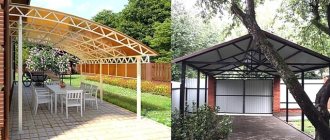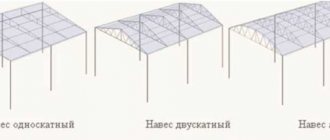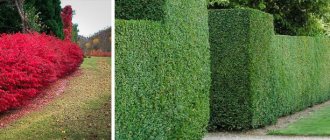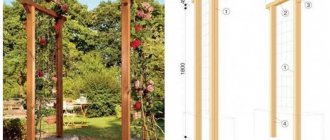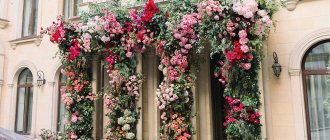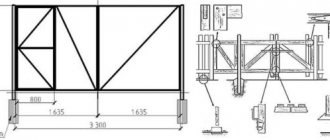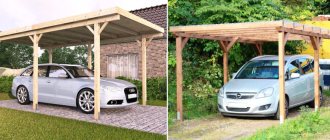It is not so easy to answer unambiguously the question of what is the best material to make a canopy in the yard, if only for the reason that you need to take into account several different factors. Including why you intend to build a shed in your yard. That is, what benefits are you going to get from this construction?
This of course does not mean that I am not going to give you specific advice on this issue. I simply suggest that you consider several of the most common options, and then draw conclusions.
What is the best material to make a canopy in the yard for practical reasons?
Currently, the choice of modern building materials is quite large. But the most popular for building a canopy are polycarbonate and metal profiles, which are often also called corrugated sheets or corrugated sheets.
These two materials have completely different characteristics, but both are successfully used for the construction of canopies.
Here we will compare them in terms of cost and operational parameters.
We just need to immediately decide by what criteria we will compare polycarbonate and metal profiles.
The most important to me are strength and durability, ease of installation, light transmission, appearance and, of course, price.
In addition, you need to take into account the material from which the canopy frame will be made.
So, let's start with polycarbonate.
Creating a Project
Creating a Project
When choosing a design project, it is worth deciding on the following parameters:
- dimensions and purpose of the structure;
- plot size;
- snow and wind loads;
- snow depth and expected annual precipitation;
- structural features of the main structure.
A pre-created project allows you to choose the best solution and select high-quality material
Before installation work, a drawing must be completed. Based on the size of the building, the required amount of material is determined.
Helpful information! When creating a carport, it is worth considering the passage of a loaded vehicle.
Canopy in the courtyard of a private house made of polycarbonate: pros and cons
You probably know what polycarbonate is. But let's take a quick look at its characteristics.
Polycarbonate is a polymer plastic that has a monolithic, and more often cellular or honeycomb structure.
Polycarbonate is produced in thicknesses of 4, 6, 8, 10 and 16 mm.
For canopies in private households, material with a thickness of 8-10 mm is most often used.
There is also thicker polycarbonate with a thickness of 20, 25 and 32 mm, but this is used primarily for industrial purposes.
The standard length of polycarbonate sheets is 6 or 12 meters.
Standard width is 210 mm.
Cellular polycarbonate has been known for decades, but still looks impressive and modern. Moreover, it comes in different colors, of which there are about ten.
The advantage of polycarbonate over other materials is that it allows the production of arched canopies and other, more complex shapes.
Another quality that is unique to polycarbonate is its light transmittance.
Depending on the thickness and color of the material, it is 35-98%.
True, this quality can also be a disadvantage if you live in the southern region and do not want the canopy to get too hot in the sun. In this case, you should choose the color of polycarbonate that is less translucent. Bronze-colored polycarbonate has the lowest light transmission.
But when choosing a color, keep in mind that colors such as green and blue will make your face not very pleasant to look at under the canopy. Unless of course it has any meaning to you.
The next advantage of polycarbonate is that it is lightweight and can be installed even by one person.
Another positive quality is that it is not “noisy” when it rains, unlike a metal coating.
The price of polycarbonate is quite affordable and depends mainly on the thickness of the sheet.
Above I cited the positive properties of polycarbonate as a material for making awnings in the yard. Now let's talk about his not so strong sides.
The load-bearing capacity of polycarbonate is lower than that of corrugated sheets, so to ensure the required rigidity and strength of the coating, it will be necessary to make a frame with a large number of ribs. This requires more material, usually profile pipe. And the amount of work is increasing.
The service life of polycarbonate is 10-15 years, which is half that of a metal profile.
Cellular polycarbonate fades over time in the sun. Its color becomes a little faded. Although high-quality polycarbonate has an ultraviolet coating.
It is advisable to seal the ends of polycarbonate sheets using any available method. Otherwise, water entering the honeycombs in the fall at sub-zero temperatures can destroy the material, leading to cracks.
Well, I indicated above that good light transmission of the material can be both an advantage and a disadvantage. If the canopy is not well ventilated in the summer, it will be stuffy under it.
We briefly examined the performance characteristics of a canopy made of cellular polycarbonate. Now I propose to look at several examples of ready-made polycarbonate canopies.
Design and location
Based on their structural features, there are several types of buildings with a polymer coating, these include the following canopies:
- built-in, they are planned at the construction design stage;
- attached sheds, can be attached to any outbuilding;
- separate, installed on the site as a separate, targeted structure.
Additionally, do-it-yourself canopies can be divided into stationary and mobile, collapsible and sliding, characterized by increased functionality.
Examples of polycarbonate canopies
In this selection of awnings, I tried to show you different options. Both for wealthy people with expensive houses, and for more modest buildings. Perhaps something will be useful to you as an example.
In agreement with neighbors
In accordance with the Civil Code, neighbors can enter into an agreement to erect a shed in violation of sanitary standards. However, it is advisable to clarify compliance with fire safety requirements.
As a rule, a controversial situation is the construction of a canopy on a boundary or a slope towards neighbors.
If the owner of the neighboring house does not object, then such construction is not prohibited. The neighbors' decision must be made in writing and certified by a notary.
The document will help protect the rights of the owner in the event of a quarrel between neighbors or the sale of an object by the owners of a neighboring plot.
Canopy in the courtyard of a private house made of metal profiles: advantages and disadvantages
The second most popular material for making awnings in the yard is metal profiles or corrugated sheets, if that name is more familiar to you.
According to its purpose, corrugated sheeting is produced as wall, roofing, load-bearing and universal.
For our case, that is, for making a canopy in the yard, the optimal brands will be C20, C20K, C21, NS35 and MP. Corrugated sheeting of other brands, such as NS44, H57, H60 and H75, has a higher wavelength and is intended mainly for apartment buildings and industrial construction.
Galvanized corrugated sheets are produced in standard sheets 6 and 12 meters long.
Many manufacturers cut corrugated sheets with decorative coatings from 1.0 m in order to expand the range.
The width of metal profiles of different brands may vary. For painted ones it is 1100 mm.
Let's take a closer look at the performance characteristics of this material. As with polycarbonate, let's start with the positive qualities of the material.
An important advantage of corrugated sheeting is its higher durability. Its average service life is about 30 years, which is quite acceptable in most cases.
In addition, corrugated sheeting can withstand significantly greater loads compared to polycarbonate. If you live in a region where there is significant snow cover in winter, then this quality is essential.
The higher rigidity and strength of corrugated sheeting makes it possible to produce a canopy frame with a much smaller number of sheathing ribs compared to polycarbonate. This saves both money and time.
Laying corrugated sheets is very simple and does not require special skills.
The light weight of the sheets allows even one person to do the job.
Corrugated sheeting with decorative coating has a fairly large selection of colors, so you can easily choose what best suits the color of your house roof or fence.
A canopy made of corrugated sheets heats up significantly in the sun, but since it is not translucent, it creates a shadow. Therefore, under such a canopy it is not as hot as under a polycarbonate canopy.
The price per square meter of corrugated sheeting is slightly lower than that of polycarbonate.
The coating on corrugated sheets practically does not fade. In any case, it is not noticeable.
In what way does corrugated sheeting lose to polycarbonate?
Firstly, the corrugated sheeting makes noise in the rain.
But the main thing is that it does not allow you to build canopies of complex shapes. To lay corrugated sheeting, only a flat surface is required. For this reason, it is difficult to build something original.
Of course, you can lay corrugated sheeting in a wave along the decking, and not across it, as it should be. Then it can be bent in the same way as polycarbonate. Although this is not entirely correct from the point of view of organizing drains, if the shed is adjacent to the house. Yes, and you can use corrugated sheeting in this way only with a small comb.
Still, let's look at a few examples of canopies using corrugated sheets.
Fencing on the site
The existing law and the Civil Code, which regulate the construction procedure on private land, provide for the mandatory construction of a fence in any permitted form. The functionality of the fence is diverse and allows you to solve several multifaceted problems at once:
- limit your plot of land from the roadway and neighboring landownership, prevent possible territorial disputes and encroachments on private property;
- protect objects standing on the site from street noise and dust, prevent the ingress of debris and the destructive effects of wind;
- obstruct the view of the activities of the landowner and his household by curious or unfriendly persons;
- prevent intruders and robbers from entering individual housing construction or the territory adjacent to the house;
- ensure the security and confidentiality of private life guaranteed by law at the dacha, in a private house and even in SNT;
- create a decorative component that is in harmony with other buildings and green spaces;
- become a guideline for marking the boundaries of land ownership and a determining constant for compliance with distance standards regulated by law, building codes and regulations (SNiP), sanitary and fire safety requirements.
Suburban area
The distance between the house and the fence is not an unambiguous value. Its definition depends on the side of the location - front, rear, with an adjacent foreign object, on the border with a neighbor's property in gardening or in the private sector.
The permissible distance varies due to the need to maintain a distance from the house to a busy highway or roadway (to the road). It depends on the need for a certain distance to another individual housing construction, a temporary building at the dacha or a permanent building in SNT, and is also determined by the norms of indentation from the neighbors’ fence.
Near a private house
Options for canopies made of metal profiles
I said above that laying corrugated board requires a flat surface, but some interesting options are possible even in this case. So maybe this will suit your situation better.
How many meters to retreat and general distance standards
The decision to build individual housing construction on the territory of one’s own land ownership depends on many components and is determined by existing SNiP. They are developed taking into account many years of construction practice, experience gained in construction safety techniques and human safety requirements. They are equally important when constructing an apartment building in an industrial manner or self-construction of individual housing construction.
Layout of buildings on the site according to SNiP
The practical value of the developed SNiPs is great. When considering territorial claims and mutual claims for improper construction of a building, they are accepted as the current standard.
It doesn’t matter whether we are talking about a lawsuit over a building that was not erected at the proper distance from a neighboring property, or distance from a neighbor’s fence. In addition to several SNiPs, fixed as
guidelines for action at the federal level, there are sanitary and fire safety standards, as well as local legislation.
Regional authorities can consolidate the necessary changes they have made, and they also need to be taken into account when planning the placement of residential and commercial facilities.
When determining at what distance a house can be placed from a neighbor’s fence according to the law and from what line on one’s property one is allowed to make an indentation, these amendments must also be taken into account.
Standard location of buildings in SNT and individual housing construction
Alternative canopy materials
We looked at two materials that are the most popular when building sheds in the yard. This is cellular polycarbonate and metal profile.
Is there an alternative to these materials?
Yes, there is, but not always the best.
The most worthy replacement for a metal profile would be metal tiles.
Its service life is just as long. And in general, in terms of technical parameters, it is close to a metal profile. And it even has some advantages. First of all, it looks more attractive on the roof than a metal profile.
The rigidity of metal tiles is slightly higher than that of metal profiles.
The snow moves off it less. This is important if you don't want it to fall on your head. But this only applies to flat canopies.
In this case, snow retainers are installed on the metal profile.
But in some ways, metal tiles are inferior to metal profiles.
Firstly, it is more troublesome to lay it. Although the work is not too difficult.
It is necessary to install transverse veins strictly at a certain distance from each other, since the metal tiles are not attached arbitrarily, but only in the recesses below the ridge.
Metal tiles are somewhat more expensive than corrugated sheets.
In general, this is a good option for building a canopy in the yard.
Are there any other options?
There are, but they are worse than the previous ones in terms of performance properties.
One of them is ondulin. Essentially the same slate, only produced using imported technology and painted in different colors.
It is lighter than domestic slate and is environmentally friendly.
This material is easy to install.
It has a reasonable price.
But ondulin also has disadvantages.
Its service life is 10-12 years.
Its paint fades and fades quite quickly.
It cannot withstand heavy snow loads compared to metal coating.
And most importantly, ondulin is flammable.
Another roofing material is the so-called soft roofing or soft tiles, as it is also called.
The ancestor of soft roofing is roofing felt. True, the performance characteristics of the new material have become significantly higher.
I will not dwell on this roofing material in great detail, but will only indicate its positive properties and disadvantages.
The advantages of this roofing material can be considered the following:
- original appearance of the roof;
- quick installation with a certain skill;
- sufficient choice of colors and shape options;
- suitable for roofs of complex shapes;
- has low weight;
- fireproof, unlike roofing felt.
The following qualities can be considered disadvantages:
- the price is higher than that of corrugated sheets or metal tiles;
- a continuous covering of boards or plywood is required, and a soft roof is laid on it;
- between the base of the roof and the soft roof, a special substrate must be laid;
- the material is not suitable for roofs with a slope of less than 12 degrees.
As you can see, there are not very many shortcomings, but they are serious. Therefore, it is worth considering before choosing this option for building a shed.
Distances from outbuildings to the fence
Construction standards regulate the location of outbuildings on the site relative to the fence:
- If it is planned to build a shed for storing gardening tools or a garage on the territory, the minimum distance from the fence should be 1 m. The slope of the roof slope must be directed to your site.
- If small animals are to be raised in the barn, the distance from the boundaries of the site will be at least 4 m. Greenhouses using organic fertilizer are placed at the same distance from the fence.
- For structures with an increased fire hazard where open fire is used, it is not recommended to bring the structure closer to the fence than 5 m. This list includes baths, boiler rooms, and solid fuel saunas.
- The distance from the garage to the fence is at least a meter. But only if the remaining buildings are 6 m away from the fence.
The rules for the location of buildings on a plot of land and the distances between them should not be ignored, not only to avoid problems with the law, but also for the purpose of convenient and safe operation of these buildings.
Permitted distances from buildings to the fence, established by sanitary, household and fire safety standards
- Showers and toilets are allowed to be located on the site no closer than 2.5 m from the fence. Baths and saunas using gas fuel and electricity can be built at the same distance.
- Spreading tall trees should not be located closer than 3 m from the fence. The distance is determined from the center of the trunk to the edge of the area. If this condition is met, the shadow from the crown will not disturb the neighbors.
- Medium-sized trees can be planted no closer than 2 m, and shrubs - 1 m from the boundaries of the territory.
Building codes indicate the minimum permissible distance between buildings and plantings
Polycarbonate carport at the dacha: the best options
It may be necessary to build a canopy not only in the courtyard, but also in the country house. For example, in order to protect the car from direct sunlight and other unfavorable factors.
For example, let's look at canopy options using polycarbonate.
There is no point in describing the technical characteristics of this material for the reason that they were discussed above.
It must be said that a carport in a country house is not fundamentally different from a carport built in a courtyard on a personal plot. The only difference may be that it may be more modest if you do not have a luxurious dacha. And therefore less expensive. Both financially and in terms of labor costs.
It is not necessary to build such a canopy on a concrete foundation. It is enough to dig metal posts into the ground.
You can generally install the canopy on a metal frame and then it can be moved if necessary. Of course, it won't be very easy, but four men can handle it.
Of course, you can make a carport not only from polycarbonate. Corrugated sheets or metal tiles are quite suitable for this. It's up to you to decide.
By the way, in many cities such canopies can be purchased ready-made, as in the photo below.
Preparatory work
Preparatory work
Before the planned sheds attached to the house are created, photos of which can be viewed on the website, it is necessary to carry out preparatory work. For this purpose, a suitable area is marked out, and trees are uprooted from it. The clean area is leveled. At the same time, sand and gravel are added.
Some durable sheds require a foundation
Recesses are drilled under the canopy supports. And at this stage it is worth considering laying the cable under the lighting sources. A certain step for placing supports is selected. It depends on the weight of the roof and frame part.
The number and placement of racks must be calculated in advance
The stands are lowered into the prepared pits and filled with concrete mixture. The pillars are set according to level.
Important information! If groundwater is located nearby, then the ends of the pillars need to be additionally waterproofed. Metal supports are pre-treated with a primer.
Drawing conclusions
The purpose of this article was to answer the question of what is best to make a canopy in the yard near the house or in the country. I tried to describe the advantages and disadvantages of most popular roofing materials. And you will have to draw a conclusion about which one to give preference to. For the reasons that it will depend on your financial capabilities and preferences.
But in any case, I approve of your desire to make your life more comfortable and wish you good luck in this.
Sincerely, Tkachenko Alexander.
Allowable distance between neighbors' houses
If a plot of land for individual housing construction is purchased in the private sector, where neighbors already live, when laying a house, you should take into account the existing buildings.
According to the requirements of SNiP, the distance from the building to the boundary of the site depends on the material of the building:
- The largest setback should be from an existing wooden building: 15 m when building a new house made of wood and 10 m - from stone, brick and concrete.
- If both houses are made of brick or concrete, but have wooden floors, the distance between such residential buildings should not be less than 8 m.
- Buildings made of non-combustible materials without wooden elements can be located closest - this is a distance of 6 m.
- If houses have 2–3 floors, the safe distance between them according to SNiP is more than 15 m.
The position of objects on the territory of a private plot is not strictly regulated by fire safety standards.
The minimum permissible distance between neighboring houses is 6 m
Decorative design
A practical canopy can also be beautifully decorated. Give it your own twist. There are many design options, for example:
- You can make a closed canopy by installing wooden bars on the sides;
- Cover the load-bearing supports with savage;
- Plant hanging varieties of plants and grapes around;
- Partially glaze the structure;
- Install a decorative fireplace inside;
- Decorate with forged products;
- Decorate the building with bright colors.
SNiP requirements
SNiP 30-02-97 as amended in 2022 and SP 53.13330.2011 require obligatory distance from the object with territorial delimitation functions to other functional objects in the following parameters:
- The minimum distance from the fence to the house should not be less than 3 m, and measurements are taken exclusively from the protruding part - the edge of the roof, canopy, veranda or terrace, or the base extended for some purpose. Failure to comply with this rule in relation to a neighbor's fence may give rise to legal action and complaints to supervisory authorities. There are cases when a claim was satisfied on the basis of several tens of centimeters, because the distance to the neighbor’s fence was measured not from the edge of the roof, but from the foundation of the house.
- The construction of outbuildings for keeping livestock or poultry must be carried out at a distance of at least 4 m. This is provided not only by the rules of building regulations, but also by sanitary standards. A shorter distance is not allowed due to the possibility of clogging and contamination of neighboring crops, causing visual and olfactory inconvenience. The extension of such structures closely or at a shorter distance is strictly unacceptable. This rule also applies to a private house on a plot of land in a populated area and one built in a gardening partnership.
- A three-meter interval between a sauna, bathhouse, smokehouse or barbecue - any type of functional purpose from which the fence is exposed to a potential fire hazard is required in any case. Fire safety requirements are not limited to a distance of 8 m. But, since the state has entrusted the responsibility for compliance with them to homeowners, owners of one-story houses can rely on SNiP standards as amended in 2018. Those with two or more floors may face complaints from inspecting and supervisory authorities.
- Standards for planting trees, especially in non-profit gardening partnerships, are also ambiguous. As far as is known from the standards, when planting trees, it is necessary to focus on their height. But decorative, fruit or thorny shrubs are allowed to be planted from a neighbor’s fence at a distance of only 1 m. And a decorative flower bed of plants can be freely placed directly on the strip under the installed fence.
- Standards for the placement of garages, sheds and restrooms have been established more democratically. They are officially allowed to be erected at 1 m height. But here it is necessary to take into account other nuances. For example, that the construction of a septic tank requires maintaining other distances - from the water source and the neighbor’s house, as well as from other objects specified in the rules, if they are located near the local area. There is a special law regulating the construction of toilets and cesspools, and violating it risks serious administrative and legal liability.
Distances between outbuildings in the village according to the law
The norms provided for by the charter of a particular non-profit gardening partnership may provide for a greater or lesser distance between the fence and the road or buildings. The same applies to instructions from local authorities or regional legislation.
The optimal disposal in this case will be in accordance with the statute or order of the local authorities, which you need to be aware of. Before you build anything, you need to make sure that the construction complies with all existing regulations.
Sources
- https://law-divorce.ru/rasstoyanie-ot-navesa-do-zabora-sosedej/
- https://HomeMyHome.ru/navesy-pristroennye-k-domu-foto.html
- https://m-strana.ru/articles/-raspolozheniya-na-uchastke-zhilykh-postroek-zabora/
- https://dachadesign.ru/navesy-iz-polikarbonata/
- https://allo-urist.com/rasstoyanie-ot-navesa-do-zabora-sosedej/
- https://stroydomkin.ru/stroitelstvo-doma/normy/rasstoyanie-ot-doma-do-zabora
[collapse]
